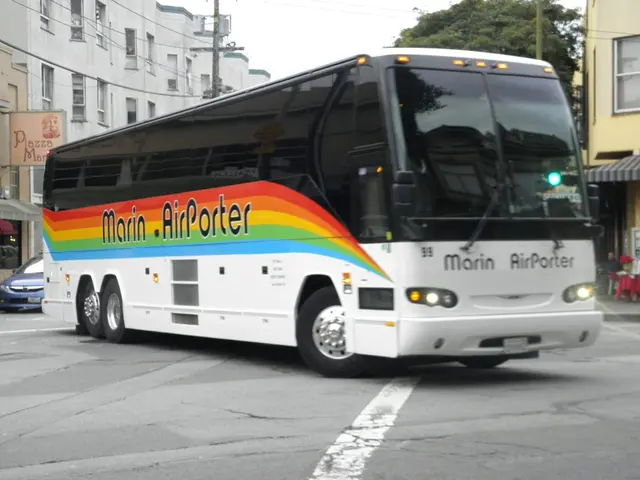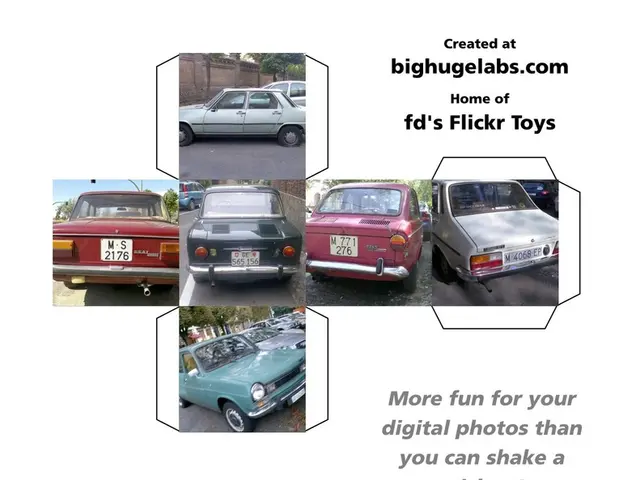Navigating Air Quality: Germany's Cleanest and Dirtiest Vehicles on the Road
Germany's Neatest and Grimiest Vehicles: Their On-Road Journeys - Germany's Vehicles with the Cleanest and Dirtiest Emissions on the Road
Calling all car enthusiasts and eco-conscious drivers! The cleanliness of cars on German roads varies greatly, and understanding the differences can help you make informed choices. Let's dive into where the cleanest and dirtiest cars are driving across this auto-loving nation.
- *
Cities and districts across Germany show significant discrepancies in exhaust technology, owing to the location of vehicle registrations. Data from the Federal Motor Transport Authority (KBA), analyzed by the news agency dpa, reveals that the proportion of cars with relatively outdated exhaust systems ranges from one-tenth to one-third, depending on the district.
Taking the lead with 33.7% of vehicles registered under Euro 1 to Euro 4 emission standards, Lüchow-Dannenberg, Lower Saxony, stands out as Germany's dustiest district. The cities of Elbe-Elster and Duisburg, with 31.7% and 30.7% of cars under the same emission standards respectively, follow closely behind. Emmendingen, Nienburg, Gelsenkirchen City, Spree-Neisse, Herne City, and Görlitz also show values above 30%.
However, not all cities are as grimy. Wolfsburg, a hub and home to Volkswagen, boasts a significantly cleaner proportion of just 10.9%, while Wiesbaden stands at 15.4%, Suhl at 15.9%, Munich district at 16.1%, and city at 17.8%. Compared to other districts, these areas benefit from a higher number of new self-registrations and company cars, skewing the statistics in favor of cleaner vehicles.
However, it's essential to bear in mind that not all cars are regularly driven in the district where they're registered. This becomes evident in Wolfsburg, where the high volume of 973 cars per 1,000 residents suggests significant car commuting beyond the district's borders.
When focusing on the cleanest cars, the story changes. Car cities take the top spots. If we consider the proportion of pure electric vehicles and those meeting the relatively newer Euro 6 emission standard, Wolfsburg edges out the competition with 77.2% of vehicles, followed by Wiesbaden with 70.6% (notably high due to many company cars). Munich city and district trail slightly behind, with 64.8% and 64% of clean vehicles, respectively. The Main-Taunus district, Ingolstadt (home to Audi), and Stuttgart (Mercedes-Benz headquarters) trail closely behind in the low sixties. Occasionally, increased affluence may influence car choices in wealthier areas, leading to a higher ownership of newer, cleaner vehicles.
- Vehicle
- Exhaust Emissions
- Mobility
- Germany
- Wolfsburg
- Munich
- Wiesbaden
- Federal Motor Transport Authority
- KBA
- Duisburg
Understanding the차이차이
While there is yet to be an official, up-to-date public dataset detailing the exact distribution of "clean" (typically electric or low-emission) versus "dirty" (internal combustion engine, higher emissions) cars in every German city, recent automotive sales, public registrations, and industry reports offer valuable insights.
City and Region Variations
- Urban vs. Rural: Urban centers, like Berlin, Hamburg, and Munich, boast a higher share of clean vehicles due to efficient charging infrastructure, stringent environmental regulations, and a growing preference for sustainable transportation options.
- Rural Areas: Lower prevalence of emission-reducing vehicles persists in rural Germany due to the lack of charging infrastructure and a reliance on longer-distance travel in sparsely populated areas.
Cities with the Most and Least Clean Cars
| City/Area | Clean Car Proportion | Notes ||-------------------|---------------------|--------------------------------------------------------------------------------------------------|| Munich | Highest | Leading the charge in electric vehicle adoption, backed by local incentives and plentiful charging infrastructure. || Berlin | High | Strong public transportation integration, EV incentives, and urban mobility initiatives contribute to the city's clean-car preference. || Hamburg | High | Thriving EV network and progressive climate policies continue to drive sustainable transportation choices in the port city.|| Stuttgart | High | As a hub of the auto industry and committed to promoting clean technologies, Stuttgart boasts a robust electric vehicle presence. || Rural Bavaria, Saxony, etc. | Lowest | Lower adoption of clean vehicles prevalent in these regions due to limited charging infrastructure and distant commuting. |
- Highest: Munich consistently demonstrates strong electric vehicle adoption and serves as a benchmark for other German cities.
- Lowest: Small towns and rural municipalities, such as those in eastern Saxony or parts of Bavaria, face challenges in transitioning to cleaner technologies.
Key Influencing Factors
- Infrastructure: Accessible charging networks and home charging solutions play a crucial role in promoting clean car ownership.
- Local Policy and Incentives: Cities implementing incentives such as tax exemptions, subsidies, low-emission zones, and attractive parking options see an increase in clean-car adoption.
- Economic Factors: Higher disposable incomes in urban areas lead residents to invest in newer, cleaner vehicles more frequently.
Wrapping Up
Munich, Berlin, and Hamburg continue to set the pace for clean car adoption in Germany, principally thanks to readily available charging networks and encouraging local policies. Meanwhile, small towns and rural municipalities, particularly in economically less developed regions, lag behind owing to limited charging infrastructure and dependency on long-haul travel.
Although granular data (such as the distribution by city or neighborhood) may not always be readily available, the information presented above paints a clear picture of the general state of things as of 2024–2025. Keep this information in mind as you gear up for your next set of wheels!
- The industry and environmental-science sectors play a significant role in shaping the employment policies of various communities in Germany, as they impact the air quality and cleanliness of vehicles on the road.
- In the context of transportation and environmental-science, understanding the discrepancies in exhaust technology across German districts can influence policy-making on employment policy, particularly in industries related to science, finance, and transportation.
- Given the significant differences in air quality and exhaust emissions within Germany, cities with a higher proportion of clean cars, such as Munich and Wiesbaden, may attract more employment in the science and ecological sectors, due to their commitment to sustainable transportation options and reduced environmental impact.








